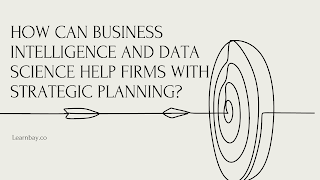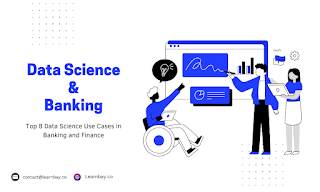How Can Business Intelligence And Data Science Help Firms With Strategic Planning?
Introduction
Data science is the study of data, and it is now particularly helpful in analytics and machine learning. Finding patterns and observations that are valuable and productive is made easier with the use of business intelligence and data science techniques.
EDA investigates the data and aids in the discovery of whole new facets of it. The central equation in business is to maximize earnings while boosting organizational effectiveness. Business intelligence is the process of sifting through data to uncover insightful management information.
Effective utilization of the data and conclusions can double a company's profits many times over. The static plan may be changed into a practical and future-proof system with the proper implementation. The system/model is not only ready but is also equipped with information and past experiences that will help it function effectively and adapt to changing conditions.
Why Data Science?
Data science, as we know it, combines tools, logic, methodologies, and machine learning algorithms to uncover hidden patterns and draw inferences from unstructured data. By analyzing data history, data science may be utilized to understand what is happening.
Data science is used in many facets of our daily lives, including weather forecasting, stock market forecasting, health sciences, finance, logistics, etc. The application of business intelligence will undoubtedly be improved by using data science and machine learning. Business efficiency will increase as a result, as will strategic planning.
Making Decisions Based on Data
The numerous techniques and procedures used in data science facilitate and direct the extraction of knowledge and information from unstructured data. If applied correctly, data science has a wide range of commercial applications.
A business analyst will collaborate with business administration and participate in EDA, a method for analyzing datasets and summarizing their critical features before interacting with the data and improving it so it may be successfully used. Businesses can make better operational, financial, and marketing choices because of the abundance of data.
Check out the trending data science certification course in Bangalore, to learn more about BI tools and techniques and get real-world experience.
Businesses might find ways to boost sales if they have historical information on which products did well at particular times or in which places. Big Data benefits retailers and companies that offer quickly moving consumer items. Numerous significant decisions that can increase revenues can be made with the right data.
Decision-making based on data has various uses. For instance, in finance, it may be determining how to use cloud services most affordably or hiring additional personnel. It could also be the least expensive strategy for advertising a new product.
Data Science at Work
In businesses, data science is used extensively across all functional domains. Credit scoring, trading, fraud detection, and database administration are all uses of it in the finance industry.
Big businesses use data science, like Amazon and Walmart, in various areas, including marketing, supply chain management, demand forecasting, and human resources. Numerous businesses have transformed into specialized data-mining firms that only work with data science.
Let's discuss an illustration. Consider that it is a holiday in India. During this period, Indian consumers exhibit a high fashion purchasing trend.
Let's say Myntra wants to boost sales throughout the season. In order to stay in stock, they will overstock the products that were sold more frequently by looking at data from the previous, say, five years. This will increase their sales.
What is the strategy for studying enormous volumes of data, then?
We can identify six stages.
Data Gathering
Data Storage
Cleaning of Data
Data Analysis
Visualization
Making Decisions
Data collecting for businesses include sales, customer history, product or service databases, performance metrics, and other information.
Data storage will keep track of all data; large corporations already do this often, and any startup business may hire a data mining firm to do the same.
Data cleaning involves deleting inaccurate data and items that might interfere with machine learning systems. There are several approaches and strategies for cleansing data.
Data analysis and visualization, two of the most crucial components, are used to identify patterns in data and draw firm conclusions.
How is it implemented in the sector?
Everywhere has data, and data and analytics teams at businesses collect data from various sources. Web analytics, application databases, customer feedback forms, BI systems, and many others might be examples.
For instance, each time we rate and review an Amazon purchase, we create two different sorts of data: the review text, which is helpful for text analytics, sentiment analysis, and other NLP activities, and the rating, which is categorical data.
A practical illustration would be how Walmart prepares for potential natural disasters by stocking up. Walmart executives wanted to know what kinds of things they should stock in quantity before Hurricane Frances in 2004. Their analytics teams examined historical purchase data to determine the products that would sell better.
A good EDA is very beneficial.
EDA can be performed on data after it has been improved and worked. It is used to investigate data, look for trends, identify anomalies, and draw conclusions using statistics. EDA innovations are a result of advances in computing.
EDA is more enjoyable with higher resolution screens, advanced user interfaces, and 4K monitors. The days of drawing a bar chart on graph paper are long gone. You may share your Power BI dashboard with the team at this time. Charts, graphs, and data visualizations provide insightful recommendations about how to proceed. Nowadays, there are a lot of data resources that may be used to make discoveries and gain new insights.
From the standpoint of data science, EDA is particularly beneficial in ensuring that the findings are accurate and suitable for the required business settings. EDA enables systematic evaluation of a data field's contents and interactions with other data fields, frequently the primary gauges for behavior or data that a business wishes to study or anticipate. Example: Customer age, spending, sale of a particular product in a specific area, etc.
Improving organizational strategic planning
Successful data mining and processing will result in effective EDA, improving business strategies for organizations and helping in strategic management, effective decision-making, and supply chain management, giving the organization a competitive edge over rivals.
This will be reflected in the overall profitability of the company. Successful strategic planning in businesses tries to achieve the intended target, goals, or future. It involves examining the big picture and maximizing the course of action.
Conclusion
This article will be helpful to you in understanding how data science can help. Data science for strategic planning will help the organization combine its approaches into a single unified corporate strategy, organizational structure, and predetermined budget because the market's dimensions and the sales of its items are projected. Companies often hire data scientists who have more practical knowledge and practices. The IBM-accredited data science course in Bangalore helps you by providing practical training with 15+ real-world projects.




Comments
Post a Comment